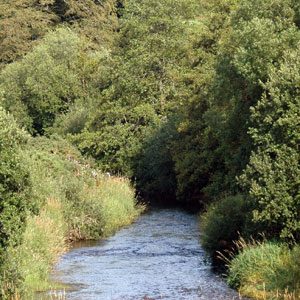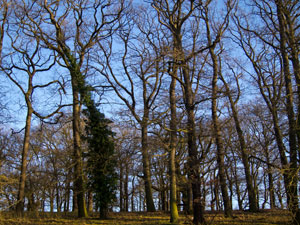The wildwood and onwards

The New Stone Age or Neolithic Period saw the development of settlements and farming. The transition from hunter-gatherer to farmer began and gradually spread across Britain. The construction of settlements and the adoption of farming (a practice that probably began some 10,000 years earlier in the Fertile Crescent) involved the clearing of woodland or forest. It was achieved with fire and the use of flint and polished stone axes.
Pollen records suggest a decline between 4000 and 3000 BC in tree species such as ash and an increase in plants such as nettles and plantains. As ash tends to grow on the edges of woods, its decline could well be associated with the clearance of parts of the wildwood for agriculture, though it may also have disappeared because of disease. It is possible that some parts of the country never quite recovered from this Neolithic clearance. It is thought that some areas like East Anglia and the Somerset levels were largely cleared of the wildwood.
 Neolithic farmers probably had sheep and goats, which their ancestors brought from the continent, pigs bred from wild boar, and domesticated dogs derived from wolves. The grazing of the goats, sheep and pigs probably had a significant effect on the woodlands of lowland Britain. The farmers also cultivated wheat and barley, which had been grown thousands of years earlier in the Fertile Crescent of the Middle East. Later metal (copper) tools were used (probably about 2220BC) though flint continued to be important for some time as evidenced by the extensive workings at Grimes Graves, near Thetford; where, black floorstone flint was mined from underground shafts using antler picks.
Neolithic farmers probably had sheep and goats, which their ancestors brought from the continent, pigs bred from wild boar, and domesticated dogs derived from wolves. The grazing of the goats, sheep and pigs probably had a significant effect on the woodlands of lowland Britain. The farmers also cultivated wheat and barley, which had been grown thousands of years earlier in the Fertile Crescent of the Middle East. Later metal (copper) tools were used (probably about 2220BC) though flint continued to be important for some time as evidenced by the extensive workings at Grimes Graves, near Thetford; where, black floorstone flint was mined from underground shafts using antler picks.
 The early settlers felled large trees and used them to make wood henges, for example, at Stanton Drew in the West Country.Others have been found, for example Seahenge at Holme next the sea in Norfolk. The posts of this structure (made of oak) have been laser scanned and it seems that many different bronze axes were used to shape the timbers, which indicates a degree of social organization and cohesion.
The early settlers felled large trees and used them to make wood henges, for example, at Stanton Drew in the West Country.Others have been found, for example Seahenge at Holme next the sea in Norfolk. The posts of this structure (made of oak) have been laser scanned and it seems that many different bronze axes were used to shape the timbers, which indicates a degree of social organization and cohesion.
Evidence of farmsteads and settlements dating from 3500 BC have been found near Mildenhall; indeed East Anglia and its coast have yielded many artefacts associated with Neolithic settlers. Occasionally dramatic finds are made, for example, Otzi.
A Neolithic man, “Otzi” was found frozen, high in the mountains between Austria and Italy, his body thought to be some 5,000 years old. Careful examination of his body, clothing and equipment has given us insights into daily life and diet in Neolithic times. Otzi and his contemporaries made good use of the plants and materials around them. Yew was used for his bow, ash for his dagger handle, woven grass and bast for the cloak (bast is made from the fibres of the linden tree), leather for a quiver, arrows fashioned from wayfaring tree and dogwood,goats hide for his leggings and jerkin, bearskin for his cap and deer skin for shoes. He carried a small pouch with a tinder kit made up of true tinder fungus, iron pyrites and flints. Interestingly, he carried a copper axe and MRI scans indicated that he died from an arrow wound (in the left shoulder).
By the time Salisbury Plain was a centre for burials and rituals, with Stonehenge at its centre, bronze tools and axes were extensively used and the area had been cleared of woodland. The next millennium witnessed increasing complexity in the various bronze tools and weapons that were produced. 800 BC saw the start of the Iron Age and its associated technological developments and innovations, for example, the potter’s wheel, the lathe and the iron tipped plough.
 Dr Oliver Rackham (Trees and Woodland in the British Landscape) estimates that about this time roughly half of England was no longer wildwood. The population of the country grew substantially during this period and was probably in excess of a million, due in part to improved varieties of crops (and hence improved diet), the cultivation of heavier soils through the use of the iron tipped plough etc. Pollarding and coppicing of woodland would ensure wood for buildings, fencing, fuel and charcoal, and would remain hugely important for centuries to come. Woodworking itself became a fine art as can be seen in the remains of boats, houses and other artefacts from this period.
Dr Oliver Rackham (Trees and Woodland in the British Landscape) estimates that about this time roughly half of England was no longer wildwood. The population of the country grew substantially during this period and was probably in excess of a million, due in part to improved varieties of crops (and hence improved diet), the cultivation of heavier soils through the use of the iron tipped plough etc. Pollarding and coppicing of woodland would ensure wood for buildings, fencing, fuel and charcoal, and would remain hugely important for centuries to come. Woodworking itself became a fine art as can be seen in the remains of boats, houses and other artefacts from this period.
Comments are closed for this post.
Discussion
[…] – An archer's portable case for holding arrows or to tremble or shake with a slight rapid motion. SCORE = […]
[…] and much of the area was covered by what has been termed ‘wildwood’ – see previous Wildwood blogs. These areas would also have been home to human populations migrating from the hinterland of […]
for further info on Otzi or Oetzi
see http://www.bbc.co.uk/news/world-europe-12599162

Has wheat got any adverse bio effect on woodlands?
Iain Angus
20 October, 2022